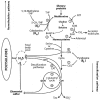Lean Body Mass Harbors Sensing Mechanisms that Allow Safeguarding of Methionine Homeostasis
- PMID: 28930162
- PMCID: PMC5622795
- DOI: 10.3390/nu9091035
Lean Body Mass Harbors Sensing Mechanisms that Allow Safeguarding of Methionine Homeostasis
Abstract
Protein-depleted states generate allosteric inhibition of liver cystathionine β-synthase (CBS), which governs the first enzymatic step of the transsulfuration cascade, resulting in upstream accretion of homocysteine (Hcy) in body fluids. A similar Hcy increase may arise from normal hepatocytes undergoing experimentally-induced impairment of betaine-homocysteine methyltransferase (BHTM) activity or from components of lean body mass (LBM) submitted to any inflammatory disorder. LBM comprises a composite agglomeration of extrarenal tissues characterized by naturally occurring BHTM inactivity. As a result of cellular injury, LBM releases high concentrations of Hcy into the extracellular space, contrasting with the disruption of normal remethylation pathways. Hyperhomocysteinemia acts as a biomarker, reflecting the severity of insult and operating as an alarm signal. Elevated Hcy levels constitute a precursor pool recognized by a CBS coding region that reacts to meet increased methionine requirements in LBM tissues, using its enhanced production in hepatocytes. Preservation of methionine homeostasis benefits from its high metabolic priority and survival value.
Keywords: cystathionine-β-synthase; homocysteine; inflammatory disorders; lean body mass; methionine pool size; protein malnutrition; sarcopenia; transthyretin.
Conflict of interest statement
The author declares no conflict of interest.
Figures



Similar articles
-
Inhibition of betaine-homocysteine S-methyltransferase in rats causes hyperhomocysteinemia and reduces liver cystathionine β-synthase activity and methylation capacity.Nutr Res. 2011 Jul;31(7):563-71. doi: 10.1016/j.nutres.2011.06.004. Nutr Res. 2011. PMID: 21840473 Free PMC article.
-
Homocysteine homeostasis in the rat is maintained by compensatory changes in cystathionine β-synthase, betaine-homocysteine methyltransferase, and phosphatidylethanolamine N-methyltransferase gene transcription occurring in response to maternal protein and folic acid intake during pregnancy and fat intake after weaning.Nutr Res. 2011 Jul;31(7):572-8. doi: 10.1016/j.nutres.2011.07.001. Nutr Res. 2011. PMID: 21840474
-
Dysregulated Hepatic Methionine Metabolism Drives Homocysteine Elevation in Diet-Induced Nonalcoholic Fatty Liver Disease.PLoS One. 2015 Aug 31;10(8):e0136822. doi: 10.1371/journal.pone.0136822. eCollection 2015. PLoS One. 2015. PMID: 26322888 Free PMC article.
-
Metabolic regulatory properties of S-adenosylmethionine and S-adenosylhomocysteine.Clin Chem Lab Med. 2007;45(12):1694-9. doi: 10.1515/CCLM.2007.341. Clin Chem Lab Med. 2007. PMID: 17963455 Review.
-
Metabolism of Sulfur-Containing Amino Acids: How the Body Copes with Excess Methionine, Cysteine, and Sulfide.J Nutr. 2020 Oct 1;150(Suppl 1):2494S-2505S. doi: 10.1093/jn/nxaa094. J Nutr. 2020. PMID: 33000151 Review.
Cited by
-
Longitudinal Analysis of One-Carbon Metabolism-Related Metabolites in Maternal and Cord Blood of Japanese Pregnant Women.Nutrients. 2024 Jun 4;16(11):1765. doi: 10.3390/nu16111765. Nutrients. 2024. PMID: 38892698 Free PMC article.
-
Combining Dietary Sulfur Amino Acid Restriction with Polyunsaturated Fatty Acid Intake in Humans: A Randomized Controlled Pilot Trial.Nutrients. 2018 Nov 23;10(12):1822. doi: 10.3390/nu10121822. Nutrients. 2018. PMID: 30477080 Free PMC article. Clinical Trial.
-
MuscleAtlasExplorer: a web service for studying gene expression in human skeletal muscle.Database (Oxford). 2020 Dec 18;2020:baaa111. doi: 10.1093/database/baaa111. Database (Oxford). 2020. PMID: 33338203 Free PMC article.
-
Plasma Transthyretin as A Biomarker of Sarcopenia in Elderly Subjects.Nutrients. 2019 Apr 21;11(4):895. doi: 10.3390/nu11040895. Nutrients. 2019. PMID: 31010086 Free PMC article. Review.
-
Diagnostic Criteria and Clinical Outcomes in Sarcopenia Research: A Literature Review.J Clin Med. 2018 Apr 8;7(4):70. doi: 10.3390/jcm7040070. J Clin Med. 2018. PMID: 29642478 Free PMC article. Review.
References
-
- Forbes G.B. Human Body Composition: Growth, Aging, Nutrition, and Activity. Springer; Berlin, Germany: 1987.
-
- Finkelstein J.D., Martin J.J., Harris B.J. Methionine metabolism in mammals: The methionine sparing effect of cysteine. J. Biol. Chem. 1988;263:11750–11754. - PubMed
-
- Di Buono M., Wykes L.J., Ball R.O., Pencharz P.B. Dietary cysteine reduces the methionine requirement in men. Am. J. Clin. Nutr. 2001;74:761–766. - PubMed
-
- Ingenbleek Y. The nutritional relationship linking sulfur to nitrogen in living organisms. J. Nutr. 2006;136:S1641–S1651. - PubMed
Publication types
MeSH terms
Substances
LinkOut - more resources
Full Text Sources
Other Literature Sources
Research Materials
Miscellaneous

